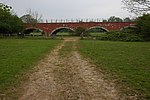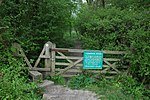Over, Tewkesbury

Over is a village in Gloucestershire, England, 2 mi (3.2 km) west of Gloucester. It lies on the A40 road in the parish of Highnam, on the west bank of the River Severn. Over was historically a hamlet of the parish of Churcham. In 1935, it was transferred to the newly formed parish of Highnam. There is some debate on the correct pronunciation of the name, with some preferring /ɒvɝ/ (oo-vurr) and others stating that it should be pronounced as /ʊ̈vɝ/ (o-vurr). The village is linked to Alney Island and Gloucester by Over Bridge, now a pedestrian bridge but until 1966 the lowest road crossing of the Severn. There was a bridge at Over, where a Roman road crossed the river, from ancient times. It was rebuilt several times, and the present bridge was built by Thomas Telford between 1826 and 1829. The River Leadon joins the River Severn just to the north of the village. The Herefordshire and Gloucestershire Canal, opened in 1795 and closed in 1881, joined the Severn between the village and the confluence of the Leadon. The canal basin at Over was restored in 2000. In 1903 a new infectious diseases hospital was opened at Over. It closed in 1991.
Excerpt from the Wikipedia article Over, Tewkesbury (License: CC BY-SA 3.0, Authors, Images).Over, Tewkesbury
A40,
Geographical coordinates (GPS) Address Nearby Places Show on map
Geographical coordinates (GPS)
| Latitude | Longitude |
|---|---|
| N 51.874 ° | E -2.271 ° |
Address
A40
GL2 8DE , Over
England, United Kingdom
Open on Google Maps






